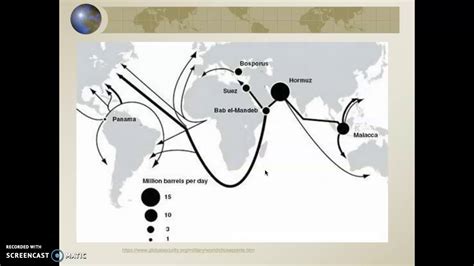Introduction

In the complex tapestry of global geography, choke points emerge as strategic crossroads that exert a profound influence on global trade, transportation, and security. These narrow passages, whether natural or man-made, have the potential to significantly disrupt or even halt the flow of goods, services, and people across vast distances. Understanding the significance of choke points is essential for comprehending the dynamics of international relations and global power projection.
Definition and Characteristics
A choke point is defined as a narrow geographical feature that restricts the movement of people, goods, or military forces through a specific area. These features can include natural formations such as straits, canals, and mountain passes, as well as man-made structures like bridges and tunnels. Choke points are characterized by their limited width and capacity, often making them vulnerable to blockades or disruptions.
Strategic Importance
The strategic importance of choke points stems from their ability to control access to vital waterways, regions, and resources. By controlling a choke point, a country or entity can exert significant influence over trade, transportation, and military operations within the surrounding area. This control can be used to impose economic sanctions, restrict enemy movements, or launch military attacks.
For example, the Strait of Hormuz in the Middle East is a critical choke point that connects the Persian Gulf to the Arabian Sea. Through this narrow passage, approximately 20% of the world’s oil supply is transported daily. Controlling the Strait of Hormuz grants a country immense leverage over global energy security.
Economic Implications
Choke points have a profound impact on the global economy. Delays or disruptions resulting from blockages or natural disasters can lead to significant losses in trade revenue. The Suez Canal in Egypt, for instance, accounts for approximately 12% of global trade volume. A single incident, such as a ship running aground, can cause massive congestion and economic ramifications worldwide.
The 2021 Suez Canal Blockage: A Case Study
In March 2021, the Ever Given, a massive container ship, became stuck in the Suez Canal. This incident caused a six-day blockage, resulting in an estimated $8-10 billion in lost revenue each day. The blockage disrupted global supply chains, delayed the delivery of essential goods, and raised concerns about the economic resilience of international transportation networks.
Environmental Considerations
Choke points can also have significant environmental implications. The high concentration of maritime traffic in these areas can lead to water pollution, habitat destruction, and increased marine noise. For example, the Strait of Malacca in Southeast Asia is one of the busiest shipping lanes in the world. The heavy traffic in this narrow passage has contributed to environmental degradation and habitat loss in the surrounding marine ecosystem.
Military and Security Implications
Choke points play a critical role in military strategy and security. By controlling a choke point, a country can restrict the movement of enemy forces or launch military operations into a neighboring region. Historically, many battles and conflicts have been fought over the control of strategic choke points.
The Panama Canal and U.S. Security
The Panama Canal, a man-made choke point that connects the Atlantic and Pacific Oceans, is vital to U.S. military strategy. The U.S. has maintained a significant presence in the Panama Canal Zone since the early 20th century to ensure the safe passage of its warships and protect its interests in the region.
Global Cooperation and Management
Given the importance of choke points, international cooperation is essential for their effective management and security. The International Maritime Organization (IMO) plays a crucial role in establishing global standards for maritime safety and security in choke points. Additionally, regional organizations and countries work together to address shared concerns and ensure the smooth flow of goods and services.
Table 1: Key Choke Points and Their Strategic Importance
| Choke Point | Location | Strategic Significance |
|---|---|---|
| Strait of Hormuz | Middle East | Controls access to the Persian Gulf and global oil supply |
| Strait of Malacca | Southeast Asia | One of the busiest shipping lanes in the world |
| Suez Canal | Egypt | Connects the Mediterranean Sea to the Red Sea |
| Panama Canal | Central America | Connects the Atlantic and Pacific Oceans |
| Bab-el-Mandeb | Red Sea | Connects the Red Sea to the Gulf of Aden |
Table 2: Economic Impact of Choke Point Disruptions
| Event | Location | Estimated Economic Loss |
|---|---|---|
| Suez Canal Blockage (2021) | Egypt | $8-10 billion per day |
| Bab-el-Mandeb Blockade (2015) | Yemen | $2 billion per day |
| Strait of Hormuz Closures (2019) | Iran | $1 billion per day |
Table 3: Environmental Impact of Choke Points
| Choke Point | Environmental Concern |
|---|---|
| Strait of Malacca | Marine pollution, habitat destruction, noise |
| Suez Canal | Water pollution, oil spills |
| Panama Canal | Deforestation, habitat loss, invasive species |
Table 4: International Cooperation and Security
| Organization | Role |
|---|---|
| International Maritime Organization (IMO) | Sets global standards for maritime safety and security |
| Straits and Channels Commission (Red Sea) | Promotes cooperation among countries bordering the Red Sea |
| Association of Southeast Asian Nations (ASEAN) | Works to ensure the safety and security of the Strait of Malacca |
Conclusion
Choke points are pivotal geographical features that exert a profound influence on global trade, transportation, and security. Their strategic importance and economic implications make them key considerations in international relations and global power projection. Understanding the dynamics of choke points is essential for policymakers, businesses, and individuals alike to navigate the complexities of the globalized world. By fostering international cooperation and embracing innovative solutions, we can mitigate the risks and leverage the opportunities presented by these critical crossroads.
